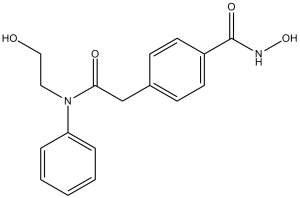HPOB is a novel, potent and selective inhibitor of histone deacetylase 6 (HDAC6) with potential anticancer activity. It exhibits >30-fold selectivity for HDAC6 over other HDAC isoforms and inhibits HDAC6 with an IC50 of 56 nM.
Physicochemical Properties
| Molecular Formula | C17H18N2O4 | |
| Molecular Weight | 314.34 | |
| Exact Mass | 314.126 | |
| Elemental Analysis | C, 64.96; H, 5.77; N, 8.91; O, 20.36 | |
| CAS # | 1429651-50-2 | |
| Related CAS # |
|
|
| PubChem CID | 71532921 | |
| Appearance | Off-white to pink solid powder | |
| Density | 1.3±0.1 g/cm3 | |
| Index of Refraction | 1.649 | |
| LogP | -0.05 | |
| Hydrogen Bond Donor Count | 3 | |
| Hydrogen Bond Acceptor Count | 4 | |
| Rotatable Bond Count | 6 | |
| Heavy Atom Count | 23 | |
| Complexity | 388 | |
| Defined Atom Stereocenter Count | 0 | |
| SMILES | O=C(N(CCO)C1=CC=CC=C1)CC2=CC=C(C(NO)=O)C=C2 |
|
| InChi Key | RFAZNTABYJYOAR-UHFFFAOYSA-N | |
| InChi Code | InChI=1S/C17H18N2O4/c20-11-10-19(15-4-2-1-3-5-15)16(21)12-13-6-8-14(9-7-13)17(22)18-23/h1-9,20,23H,10-12H2,(H,18,22) | |
| Chemical Name | N-hydroxy-4-[2-[N-(2-hydroxyethyl)anilino]-2-oxoethyl]benzamide | |
| Synonyms |
|
|
| HS Tariff Code | 2934.99.9001 | |
| Storage |
Powder-20°C 3 years 4°C 2 years In solvent -80°C 6 months -20°C 1 month |
|
| Shipping Condition | Room temperature (This product is stable at ambient temperature for a few days during ordinary shipping and time spent in Customs) |
Biological Activity
| Targets | HDAC6 ( IC50 = 0.056 μM ); HDAC3/NCOR2 ( IC50 = 1.7 μM ); HDAC8 ( IC50 = 2.8 μM ); HDAC1 ( IC50 = 2.9 μM ); HDAC10 ( IC50 = 3.0 μM ); HDAC2 ( IC50 = 4.4 μM ) | ||
| ln Vitro |
|
||
| ln Vivo |
|
||
| Enzyme Assay | The fluorogenic release of 7-amino-4-methylcoumarin from substrate upon deacetylase enzymatic activity is used to detect the in vitro activities of the 11 recombinant human zinc-dependent HDAC enzymes. Ten percent DMSO in HDAC assay buffer is used to prepare a series of dilutions of the unique HDAC6 compound, tubacin, and SAHA. Five microliters of each dilution is then added to a 50 microliter reaction, ensuring that the final concentration of DMSO is one percent in each reaction. The enzymatic reactions are carried out in duplicate in a 50-μL mixture containing an HDAC substrate, an HDAC enzyme, an HDAC assay buffer, 5 μg BSA, and a test compound for 30 minutes at 37 °C. Following the enzymatic reactions, 50 μL of 2× HDAC developer is added to every well, and the plate is left to incubate for a further fifteen minutes at room temperature. A Synergy microplate reader is used to measure the fluorescence intensity at an excitation of 360 nm and an emission of 460 nm. The assays include positive controls (SAHA, a known HDAC inhibitor) and negative controls (no enzyme, no inhibitor, or medication with no HDAC inhibition activity). The drug concentration that causes a 50% decrease in HDAC activity when compared to the control is known as the IC50. | ||
| Cell Assay | The prescribed doses of HPOB are cultivated in normal (HFS) and transformed (LNCaP, A549, and U87) cells for a duration of 72 hours. A positive control is five micromolars of SAHA. Prism 5 was utilized to construct the graphs. | ||
| Animal Protocol |
|
||
| References |
[1]. Proc Natl Acad Sci U S A . 2013 Sep 24;110(39):15704-9. |
Solubility Data
| Solubility (In Vitro) |
|
|||
| Solubility (In Vivo) |
Solubility in Formulation 1: ≥ 2.5 mg/mL (7.95 mM) (saturation unknown) in 10% DMSO + 40% PEG300 + 5% Tween80 + 45% Saline (add these co-solvents sequentially from left to right, and one by one), clear solution. For example, if 1 mL of working solution is to be prepared, you can add 100 μL of 25.0 mg/mL clear DMSO stock solution to 400 μL PEG300 and mix evenly; then add 50 μL Tween-80 to the above solution and mix evenly; then add 450 μL normal saline to adjust the volume to 1 mL. Preparation of saline: Dissolve 0.9 g of sodium chloride in 100 mL ddH₂ O to obtain a clear solution. Solubility in Formulation 2: ≥ 2.5 mg/mL (7.95 mM) (saturation unknown) in 10% DMSO + 90% (20% SBE-β-CD in Saline) (add these co-solvents sequentially from left to right, and one by one), clear solution. For example, if 1 mL of working solution is to be prepared, you can add 100 μL of 25.0 mg/mL clear DMSO stock solution to 900 μL of 20% SBE-β-CD physiological saline solution and mix evenly. Preparation of 20% SBE-β-CD in Saline (4°C,1 week): Dissolve 2 g SBE-β-CD in 10 mL saline to obtain a clear solution. Solubility in Formulation 3: ≥ 2.5 mg/mL (7.95 mM) (saturation unknown) in 10% DMSO + 90% Corn Oil (add these co-solvents sequentially from left to right, and one by one), clear solution. For example, if 1 mL of working solution is to be prepared, you can add 100 μL of 25.0 mg/mL clear DMSO stock solution to 900 μL of corn oil and mix evenly. (Please use freshly prepared in vivo formulations for optimal results.) |
| Preparing Stock Solutions | 1 mg | 5 mg | 10 mg | |
| 1 mM | 3.1813 mL | 15.9063 mL | 31.8127 mL | |
| 5 mM | 0.6363 mL | 3.1813 mL | 6.3625 mL | |
| 10 mM | 0.3181 mL | 1.5906 mL | 3.1813 mL |
